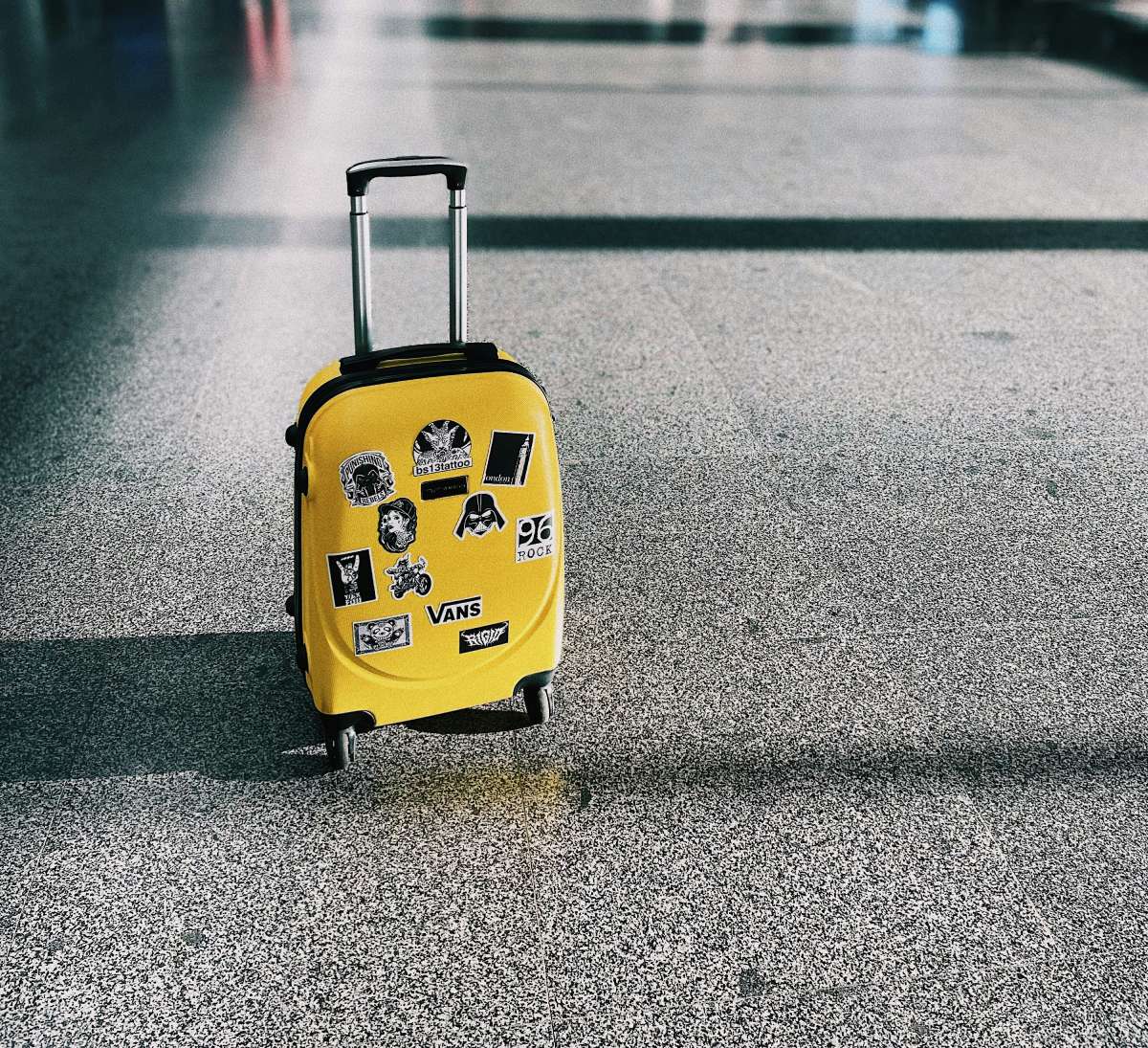Airlines That Weigh Carry On Baggage

We may be compensated when you click on links from one or more of our advertising partners. recommendations and opinions are ours alone. See our Advertiser Policy for more details.
Airlines have been increasingly charging for check in baggage making passengers taking carry ons that much more popular.
If you’ve been on a flight recently you will notice countless people lining up with rolling bags desperate for that precious overhead bin space.
Given the charges for check in bags, passengers are packing more and more into their carry ons. This has led to a bit more enforcement of carry on weights but it tends to vary airline by airline.
Almost all airlines have an official policy for carry on baggage weight and size.
While carry on bag size is generally enforced due to overhead bid limitations, weight is often inconsistently enforced.
If you are planning on traveling with a carry on bag we will break down airline policies and which airlines actually weigh your bags.
Airlines Official Carry On Bag Policies
Almost all major airlines have official carry on bag policies. These tend to vary from larger carriers that generally offer more generious policies to low cost carriers being the most restrictive.
The type of ticket you purchase can also have a major difference in carry on limits. If you purchase a premium cabin ticket the policy is generally more favorable while basic economy tickets will be the most restrictive, if they allow carry on at all.
Here’s a general overview of some major airlines and their carry-on baggage weight policies:
| Airline | Carry-On Weight Limit | Dimensions (L x W x H) |
|---|---|---|
| Delta Air Lines | Up to 40 lbs (18 kg) | 22 x 14 x 9 inches (56 x 35 x 23 cm) |
| American Airlines | Up to 40 lbs (18 kg) | 22 x 14 x 9 inches (56 x 35 x 23 cm) |
| United Airlines | Up to 50 lbs (23 kg) | 22 x 14 x 9 inches (56 x 35 x 23 cm) |
| Southwest Airlines | Up to 50 lbs (23 kg) | 24 x 16 x 10 inches (61 x 41 x 25 cm) |
| JetBlue Airways | Up to 22 lbs (10 kg) | 22 x 14 x 9 inches (56 x 35 x 23 cm) |
| Emirates | Up to 15 lbs (7 kg) | 22 x 15 x 8 inches (55 x 38 x 20 cm) |
| Qatar Airways | Up to 15 lbs (7 kg) | 20 x 15 x 10 inches (50 x 37 x 25 cm) |
| British Airways | Up to 51 lbs (23 kg) | 22 x 18 x 10 inches (56 x 45 x 25 cm) |
| Lufthansa | Up to 17.6 lbs (8 kg) (Economy) Up to 26.4 lbs (12 kg) (Business/First) | 21.6 x 15.7 x 9 inches (55 x 40 x 23 cm) |
| Air France | Up to 26.4 lbs (12 kg) | 21.7 x 13.8 x 9.9 inches (55 x 35 x 25 cm) |
| KLM Royal Dutch Airlines | Up to 26.4 lbs (12 kg) | 21.5 x 13.5 x 10 inches (55 x 35 x 25 cm) |
| Singapore Airlines | Up to 15.4 lbs (7 kg) (Economy) Up to 33.1 lbs (15 kg) (Business/First) | 21.6 x 15.7 x 9.8 inches (55 x 40 x 25 cm) |
| Cathay Pacific Airways | Up to 15.4 lbs (7 kg) | 22 x 14 x 9 inches (56 x 36 x 23 cm) |
| Etihad Airways | Up to 15.4 lbs (7 kg) (Economy) Up to 26.4 lbs (12 kg) (Business/First) | 22 x 15.7 x 9 inches (56 x 40 x 23 cm) |
| Qantas | Up to 15.4 lbs (7 kg) (Economy) Up to 33.1 lbs (15 kg) (Business/First) | 21.6 x 15.7 x 9.8 inches (55 x 40 x 25 cm) |
| Air Canada | Up to 22 lbs (10 kg) | 21.5 x 15.5 x 9 inches (55 x 40 x 23 cm) |
| Thai Airways | Up to 15 lbs (7 kg) (Economy) Up to 33 lbs (15 kg) (Business/First) | 22 x 18 x 10 inches (56 x 45 x 25 cm) |
| Japan Airlines (JAL) | Up to 22 lbs (10 kg) | 22 x 16 x 10 inches (55 x 40 x 25 cm) |
| ANA (All Nippon Airways) | Up to 22 lbs (10 kg) | 22 x 16 x 10 inches (55 x 40 x 25 cm) |
Note, these are all official policies for airlines and you can imagine all airline have them. However, that does not mean the airline actually checks the weight prior to boarding and it varies by airline.
Airlines That Weigh Carry Ons
This can be a bit tricky but not every airline will actually check the weight of your carry on bag.
If you are booked in standard economy or higher, major US airlines like Delta, United, and American rarely will actually check if your bag is under weight. Now this is very different than your bag being too large but as long as it appears the normal size they will very rarely check the weight.
However, this is not the case for international airlines. In our experience many airlines internationally are a bit more strict with cabin bag weight and these airlines include: Turkish Airlines, Emirates, Etihad, LOT Polish, Air France, Air Asia, Spirit, EasyJet, Ryan Air, and Frontier. You can expect that lower cost airlines are more strict but you will notice even larger carriers do often weigh carry ons.
Note, if you are flying in business class we’ve experience many airlines that don’t bother with the weight. Even though they have listed restrictions, airlines tend to turn a blind eye to business class passengers given how valuable they are based on the amount they spend.
To be prepared, airlines will either weigh your carry on at the check in counter or even prior to boarding. If you make it past check in we have noticed weighing at boarding to only happen if the bag appears big instead of them weighing everyones.
Nothing turns away passengers more than being nickle and dimed for a few extra pounds especially if they have paid a premium.
How Often Do Airlines Weigh Carry Ons
Even if an airline has a stated policy for carry on baggage weight it doesn’t mean they will always weight it. In our experience even airlines that do weigh only do so about 5% – 10% of the time.
This means its really up to the check in agent you have and the gate agents.
We’ve noticed airlines are more likely to weigh carry ons when the flight is full since weight is more of an issue. If you are traveling on flight with a few seats open then generally even those that do weigh may not.
Overweight Carry On Charges
So what happens if you are actually over the baggage allowance and how much will it cost? Well that certainly depends on the airline.
If an airline knows your bag is overweight there isn’t really a way to pay for the extra weight. Instead the airline will not let you bring the carry on bag on at all and instead charge you to check in the bag. This can vary from $50 all the way to $300 on some airlines.
It’s always best to be prepared for this and take steps in advance to reduce the issues you could face at the airport.
How To Navigate Carry On Baggage
There are a number of things you can do to navigate airline carry on baggage policy and reduce your chances of extra charges. Here are some tips to keep in mind next time you travel.
- Know the Weight Limit: This is easy but look up the requirements of your airline. Generally this will be between 15 – 25 lbs.
- Pack Light: Naturally consider packing light and choose versatile clothing when traveling. You can always do your laundry at a hotel but note it will cost you.
- Use Lightweight Luggage: The amount your bag weighs certainly can make a difference so try to avoid bulk carry ons by weighing them in advance.
- Limit Toiletries: Toiletries and cosmetics can add a lot weight to your carry-on bag. Opt for travel-sized containers or consider buying toiletries at your destination to save weight.
- Wear Bulky Items: If you’re traveling with large items like jackets, boots, or heavy shoes, consider wearing them instead of packing them in your carry-on.
- Weigh Your Bag Before You Leave: Using a luggage scale can help you be prepared so you are not caught off guard when you arrive.
- Consider Personal Items: Many airlines allow passengers to bring a personal item in addition to their carry-on bag. Use this to your advantage by packing heavier items like laptops, books, or cameras in your personal item.
- Be Prepared to Repack: If your bag is overweight at the airport, be prepared to repack or remove items. This may involve shuffling items around or carrying some items in your hand.
- Use Mobile Boarding Pass: If you are traveling with just a carry on consider using a mobile boarding pass. This will ensure you skip the check in counter at the airport making the odds of them weighing your bag much les.
There are a number of strategies you can do to reduce your chances of paying for a check in bag but in the end its up to a little bit of luck as well.
Summary & Takeaways
Navigating carry on weight for airlines is not always easy given the inconstancies in how they check. However, the risk is a surprise charge and being seperated from your baggage when you didn’t intend to.
While every airline has a weight policy, not all airlines will actually weigh your bags. It’s always best to be prepared though and take the tips to increase your chances of getting onboard with your bag.





